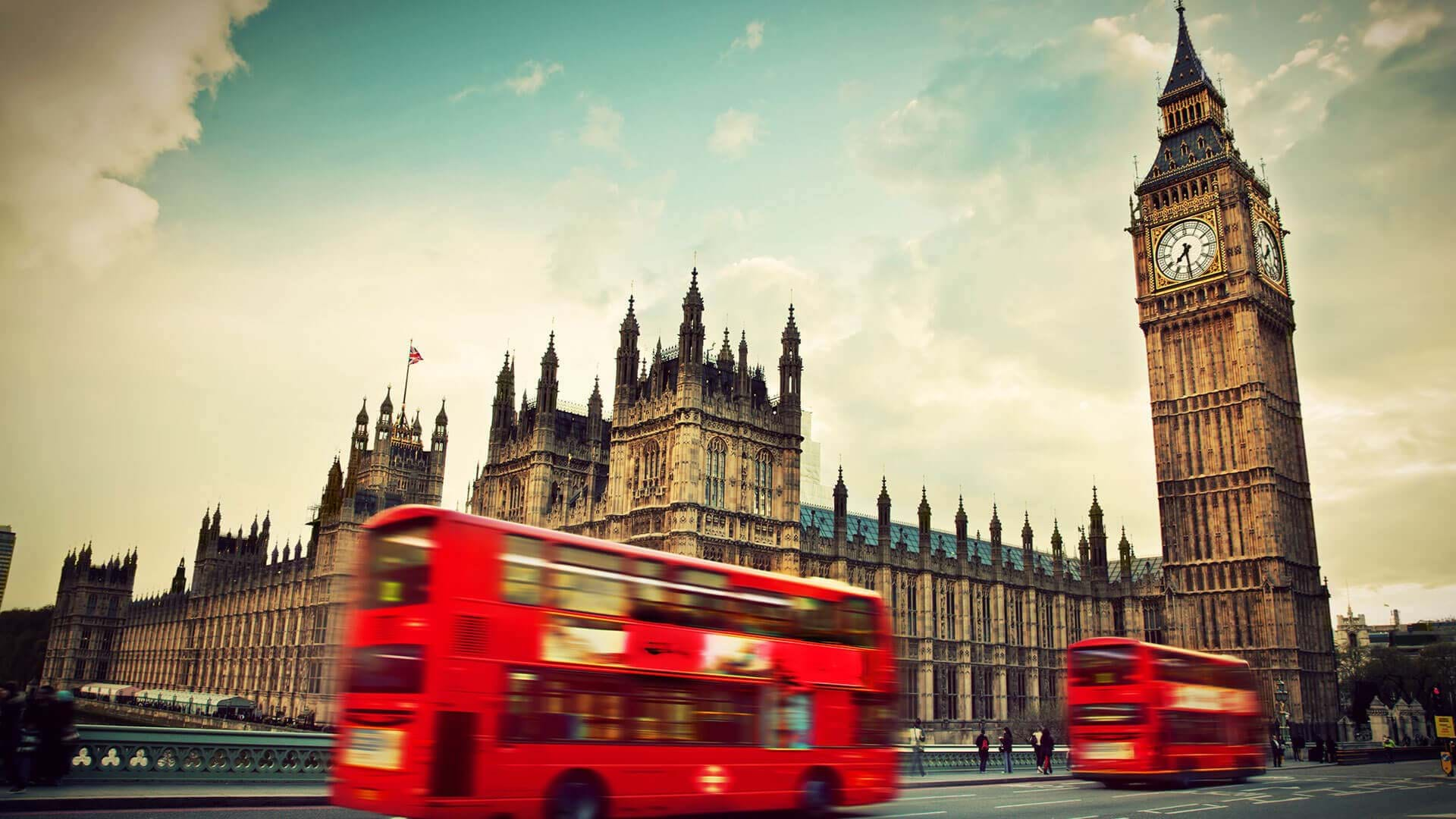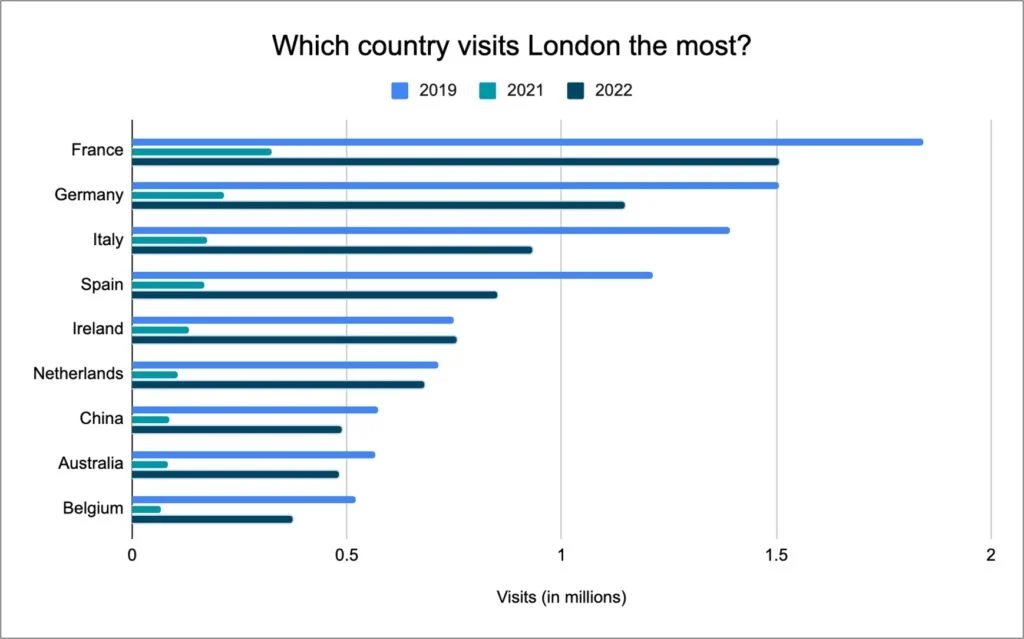
Explore UK Tourism Trends & Statistics on Inbound Tourism, Spend, Employment, Popular Tourist Destinations & more!
VisitBritain forecasts 43.4 million inbound visits and £33.7 billion will be spent in 2025. U.S. tourists drive the biggest visitor numbers, with 3.03 million visits to the UK, followed by France with 1.5 million.
With the UK's rich history, cultural attractions, quaint villages and towns, it's no surprise that the UK is so popular with international visitors. In 2024, the UK tourism industry contributed approximately £286 billion to the UK economy, representing 10% of GDP. This market is crucial to the UK economy and supports 3.8 million jobs.
Read on for more UK tourism statistics & latest industry data.
TOP TOURISM STATISTICS UK:
In 2024, the UK tourism industry contributed approximately £286 billion to the UK economy, representing 10% of GDP.
In 2024, the UK saw an estimated 41.2 million inbound visits, a 9% increase from 2023 and 1% above pre-pandemic levels.
VisitBritain forecasts 43.4 million inbound visits and £33.7 billion spent in 2025.
U.S. tourists visit the UK the most, with 3.03 million visits, followed by France with 1.5 million.
London was the 2nd highest-ranked city for international arrivals, with only Istanbul surpassing it.
In 2025, tourism is projected to contribute £257 billion to the UK economy and support 3.8 million jobs.
The British Museum was the most visited tourist attraction in the UK in 2024, welcoming over 6.5 million visitors.
42% of overseas visitors came to the UK for a holiday.
34% of visitors came to see friends or relatives.
Sightseeing is the 3rd most popular international visitor activity amongst those visiting the UK.
In 2024, the UK saw an estimated 41.2 million inbound visits, a 9% increase from 2023 and 1% above pre-pandemic levels.
Visitors to the UK made an estimated 10.8 million visits and spent an estimated £7.9 billion between April and June 2024.
VisitBritain forecasts 43.4 million inbound visits and £33.7 billion spent in 2025.
The UK is among the world's top five tourism earners (+40%).
In 2024, the US leads inbound tourism to the UK.
Indian nationals accounted for 25% of visitor visas granted, with 549,249 visas granted.
Chinese nationals accounted for 24% of visitor visas granted to the UK, which translates to 518,677 individuals.
VisitBritain forecasts the US market to be worth £6.7 billion, with American visitors contributing almost £1 in every £5 of all inbound spending.
The British Museum was the most visited tourist attraction in the UK in 2024, welcoming over 6.5 million visitors.
In 2024, London was the most popular UK city for inbound visitors. Over half of all visitors to the UK visit London.
London welcomed 10.4 million international visitors between January to June 2024.
Inbound tourism statistics show a 9% increase in inbound visitors in 2024 compared with 2023. US tourists continue to drive visitor numbers to the UK. American tourists are drawn to the UK by a combination of factors, including shared language and history, and cultural attractions. This is evident, with the British Museum being the most visited attraction.
London attracts over half of the tourists to the UK, and its rich history, diverse culture, iconic landmarks, and world-class attractions draw millions each year.
Sources: TheGuardian, UKInbound, VisitBritain, VisitBritain, Finder, ONS, Forbes, UNWTO, Visit England,
In 2024, an estimated 30 million tourists visited London, including international and domestic visitors.
In the first half of 2024, London welcomed 10.4 million international visitors.
International visitors spent £7.4 billion in London from January to June 2024, a 2% decrease compared to 2023.
In 2023, total spending reached £16.7 billion, reflecting an 18% increase from 2022 (£14.15 billion).
Tourists spent an average of £877 per visit in 2022, representing a 22% increase from the average spend of £696 in 2019.
U.S. tourists visit the UK the most, with 3.03 million visits, followed by France with 1.5 million.
London was the 2nd highest-ranked city for international arrivals, with only Istanbul surpassing it.
49.9% visited London for a holiday, followed by 28.2% who visited London to see friends and family.
Business trips also contributed significantly, bringing in 2.4 million visitors.

London attracts around 30 million visitors from around the world each year, with American tourists driving visitor numbers, followed by the French. Holidays, visiting family, and business trips are the most popular reasons for visiting the capital.
London is popular due to its history, cultural attractions, and iconic landmarks. Although London is popular and international visitor spending remains high, it has seen a decline due to the UK's high cost of living, the introduction of the Electronic Travel Authorisation (ETA) system, and the lack of tax-free shopping.
Sources: Road Genius, UK Gov,
International visitors spent an estimated £7.9 billion between April and June 2024.
VisitBritain forecasts 43.4 million inbound visits and £33.7 billion spent in 2025.
In 2025, tourism is projected to contribute £257 billion to the UK economy and support 3.8 million jobs.
In 2023, tourism directly contributed £58 billion (2.4%) to the UK economy and supported 1.2 million jobs.
The tourism sector is forecast to grow at an annual rate of 3.8%.
Tourism in the UK contributes significantly to the economy and is forecast to contribute £257 billion to the UK economy in 2025. UK visitor spend is predicted to increase by 7% compared to 2024.
The United States is the UK's largest and most valuable visitor segment. Spending by Americans is forecast to increase by 9% compared to 2024 to £6.7 billion this year, which means that almost £1 in every £5 of inbound visitor spending in the UK is by US visitors.
Sources: ONS, VisitBritain, VisitBritain, Wikipedia, UKinbound, Visit Britain,
42% of overseas visitors came to the UK for a holiday.
34% of visitors came to see friends or relatives.
17% of visitors came for business purposes.
The most popular attraction is the British Museum, attracting 5,820,860 visitors in 2023.
The top 5 cities visited by tourists in 2023 were:
London - 20,277,000 visitors
Edinburgh - 2,324,000 visitors
Manchester - 1,721,000 visitors
Birmingham - 934,000 visitors
Liverpool - 900,000 visitors
Why do people visit the UK?
Tourists to the UK primarily visit for holidays, with London being the most visited city, followed by Edinburgh. The culture, historical attractions, and natural beauty draw visitors each year. Beautiful coastlines, quaint villages, and picturesque towns attract tourists.
The UK's film and TV industry has also become a major draw for visitors, with locations featured in popular shows and movies becoming popular places to visit. Downton Abbey, Outlander, Bridgerton, and Ted Lasso attract tourists to the locations where they were filmed.
Sources: ONS, VisitBritain, UKInbound, UK Gov, Wikipedia, Royal TV Society,
Top Towns and Cities
London
Edinburgh
Manchester
Birmingham
Liverpool
Glasgow
Bristol
Oxford
Cambridge
Brighton / Hove
Visits (000s)
20,277
2,324
1,721
934
900
685
569
450
444
441
London is by far the most popular city in the UK. People love visiting the capital city because it is full of history and culture. The best museums and art galleries in the world are located there, most of which are free. It is home to Buckingham Palace, the Tower of London, Kew Gardens, and many more attractions that keep tourists coming back to London every year.
Edinburgh is the second most visited city, known for its stunning architecture, vibrant cultural scene, and beautiful natural landscapes; it is understandable why Edinburgh is so popular.
Sources: VisitBritain, Finder, UKinbound, Wikipedia,
Tourist Attraction
British Museum
Natural History Museum
Windsor Great Park
Tate Modern
Southbank Centre
Victoria and Albert Museum
National Gallery
Science Museum
Tower of London
Somerset House
Visitors (2023)
5,820,860
5,688,786
5,487,856
4,742,038
3,193,966
3,110,000
3,096,508
2,956,886
2,790,280
2,727,677
The top tourist attraction in the UK is the British Museum in London, closely followed by the Natural History Museum.
Sightseeing is the 3rd most popular international visitor activity amongst those visiting the UK.
Guided tours are popular in Scotland, with just under a third of all visitors putting a guided tour on their UK itinerary.
4% of international tourists visited wildlife attractions (including aquariums).
28% of those visiting historical sights visited castles/historic houses and religious buildings.
Over 50% of all inbound visitors to Scotland included a castle or historic house on their itinerary.
63% of international tourists looking to experience 'city life' dined in restaurants.
55% of international tourists looking to experience 'city life' went shopping.
41% of international tourists looking to experience 'city life' experienced a traditional pub.
10% of all visits to the UK included a visit to a coast or beach; this rises to 34% amongst those visiting Wales.
Nearly a third of all visits to the South West included at least one stop in the countryside or an English village.
7% of all inbound UK visits included a National Park on their itinerary.
This rose to as high as 17% of visits in Scotland and 15% in Wales.
Walking in the countryside is the most popular outdoor pursuit amongst international visitors, featuring on the list for one in five visitors.
Visitors to the UK like to experience a multitude of activities whilst visiting. In particular, Millennial tourists generally had a higher propensity to include an activity on their UK visits. Visitors over the age of 65 were more likely to include the niche activities of researching ancestry and playing golf.
Those visiting the UK for at least 2 weeks are the most likely to include the activities in their holiday. However, going to a live sports event was popular on shorter 1-3 night stays, while a guided tour was most commonly booked on itineraries of at least a week.
Sources: VisitBritain, Finder
In 2024, UK tourism is estimated to support around 4.14 million jobs, a significant increase from the 3.39 million jobs in 2023.
The ONS estimated that tourism directly contributed to 1.2 million jobs in the UK. This was 3.9% of all jobs in the UK in 2023.
Indirectly, the sector's contribution to employment reaches 3.39 million in 2023, with a forecast of 5.21 million by 2034.
The food and beverage industry employs the highest number of people, contributing to the tourism industry.
The World Travel & Tourism Council (WTTC) estimates that the UK travel and tourism sector will create 700,000 jobs over the next decade.
The United Kingdom is one of the world's most popular tourist destinations; therefore, it's no surprise that this sector creates a lot of job opportunities.
The importance of tourism to the UK economy is huge, with the sector supporting around 4.14 million jobs across the accommodation, food and beverage, travel agencies, sports and recreation activities, road and passenger transport, cultural activities, and air passenger transport.
England’s tourism sector contributes £106 billion to the British economy (GDP) when its direct and indirect impacts are taken into account, and it supports 2.6 million jobs.
Sources: VisitBritain, Finder, WTTC, Statista, House of Commons,
In 2020 the UK received 11.1 million inbound visitors, who spent £6.2 billion, a decline of 73% in visits and 78% in spending.
This represented a loss to the UK economy of £22.2 billion.
Monthly air passenger arrivals to the UK fell by 98.3% from 6,804,900 in February 2020 to 112,300 in April 2020.
Domestic and international air passenger traffic fell to less than 2% of its February 2020 levels in April 2020.
London saw the largest fall in room occupancy, with just 20% of rooms occupied in July 2020 compared with 90% in the same month in 2019.
Accommodation and travel agency businesses saw the sharpest decline in turnover during the first national lockdown, falling to 9.3% of their February levels in May 2020.
Employment in accommodation fell by 21.5% compared with the same three months of 2019.
Domestic tourist spending dropped to £34 billion in 2020 from £92 billion in 2019.
Visit Britain is forecasting 35.1 million visits in 2023 and £29.5 billion spent (104% of the 2019 level and 14% higher than in 2022).
While international tourist visits haven’t bounced back to pre-pandemic levels, Visit Britain estimates they could come to 86% of the pre-pandemic level in 2023.
The total contribution of travel and tourism to the UK’s GDP increased by 40% from 2020 to 2023.
In 2022, there were about 30 million international visits to the UK.
It's forecast that the number of visitors to the UK could reach 35.1 million in 2023.
In 2022, UK tourism’s GDP contribution was £214 billion.
Tourism’s GDP contribution should grow by 3% annually between 2022 and 2032.
The average Briton took 3.6 holidays in 2022.
UK tourists spent around £45 billion abroad in the first three quarters of 2022.
The country most visited by UK residents is Spain.
Tourists spent around £14.2 billion in London in 2022.
There were 15.6 million international visitors in London in 2022.
COVID-19 impacted the UK tourism market when travel came to a halt around the world. Monthly air passenger arrivals to the UK fell by 98.3% and ultimately the losses represented a loss to the UK economy of £22.2 billion.
Inbound international tourism to the UK was the first industry to be affected by Covid-19 and will be the last to recover, although the UK isn't at pre-pandemic levels just yet, travel & tourism to the UK's GDP increased by 40% from 2020 to 2023 and the number of inbound visitors to the UK could reach 35.1 million in 2023.
Where people have missed out on travel due to lockdowns, other factors are impacting whether people can afford travel. Increasing costs of overseas tourism stop 19% of Britons from enjoying a trip abroad, and personal finances and around 36% of consumers say they won’t be taking a holiday this summer – 14% say due to the level of their essential costs.
Sources: Money Transfers, KPMG, Parliament, ONS, Statista


